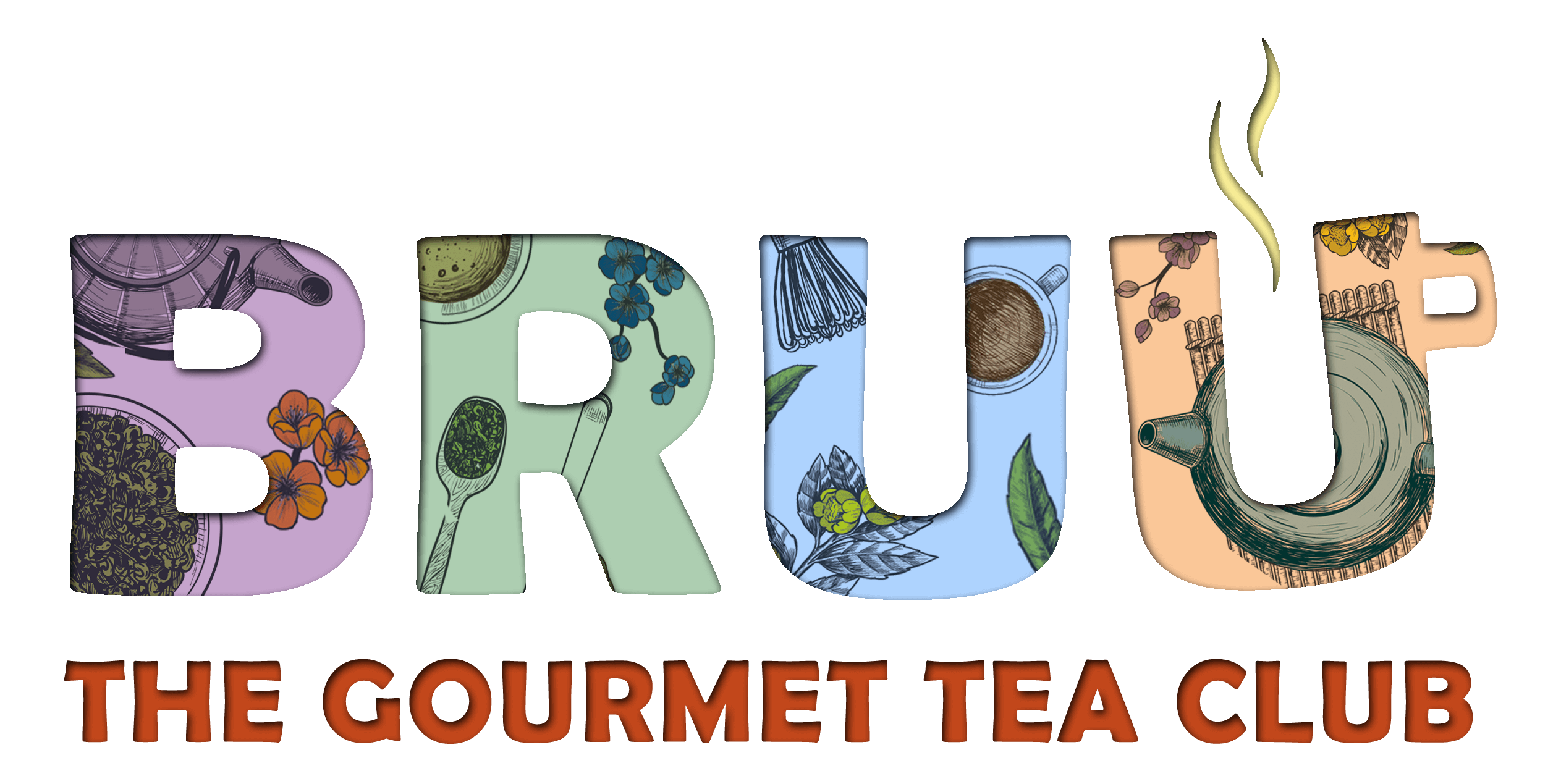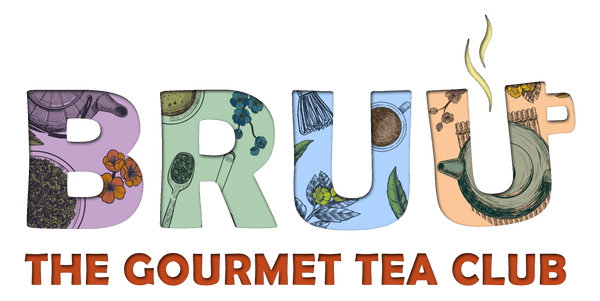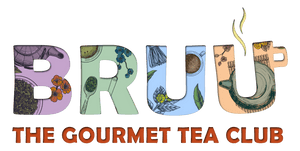A Glossary of tea

We're on a mission to introduce the world to better tasting tea and educate them on the benefits of gourmet loose tea. Tea terminology can make navigating the subject difficult so we thought we'd put together a glossary of all things tea.
A
Assam: Assam is a region in India where the world famous Assam tea is produced. The soil and climate helps to create a full-bodied tea with a light malty taste. Assam is the worlds largest tea growing region.
Ayurvedic Tea: Is a special tea first blended by Brahm Atma Singh to help bring the mind, body and soul into unity through tea. An unbalanced body he felt would lead to bad health. He isn't wrong.
B
BRUU or brew: A British term used to describe a cup of tea. It's also the name of a tea club famous for its gourmet loose tea. When we were about to launch we could not think of a suitable name so we turned to our good friend Martin Robert Hall who ingeniously came up with the name BRUU.
Bakey: If a tea has been over-fired and lost too much moisture it is called bakey.
Black tea: All tea comes from the Camellia Sinensis plant. When the loose tea leaves have been harvested they are then oxidised or fermented. The longer the oxidation the darker the tea. So black tea is a tea that has had the full oxidation process.
Blend: A term used to describe a mixture of different ingredients to produce a distinct taste. Many of the teas at BRUU are blended with different ingredients to enhance their flavor.
Broken Orange Pekoe or BOP: This is a course black tea leaf that is broken and has a citrus aroma and medium body.
Boston Tea Party: In 1773 American citizens boarded three tea ships harbored in Boston and destroyed the whole tea cargo in protest of a tea tax. It marked the start of the American Revolutionary War.
Bags: Originally introduced in the early 1800's to transport tea samples from China they are now used by over 96% of tea drinkers. Unfortunately they do restrict the way the tea leaves infuse and are mostly filled these days with low grade tea. For a proper BRUU only loose tea will do.
C
Ceylon: Ceylon was the colonial name given to what is now known as Sri Lanka but in the tea industry it is still referred to as Ceylon tea. It is the third largest tea growing region in the world.
Camellia Sinensis: The plant which all teas (black, green, white, oolong) are made from. The oxidisation process determines which tea is produced from the harvest and the longer it is left to oxidise the darker the tea. Therefore white tea has the shortest period oxidising.
China: China is the birth place of tea and the second largest producer to tea leaves.
Clean tea: If the tea leaves have been harvested well and sorted correctly into consistent grades of tea then it is referred to as clean tea. Think of it like harvesting strawberries. Some will be big and juicy whilst others may be smaller. A clean harvest of strawberries would mean the quality is consistent and free from variation.
CTC: Known in the tea industry as 'crush, tear and curl' this is a production technique used by many of the worlds tea brands and helps them to mass produce tea. With the CTC process only low grade teas can be used such as fannings or dust. So although millions of tons of tea can be produced the final product does not totally resemble tea as we would know it at BRUU.
Crystal Sugar: Used in many of the mass produced teas to artificially enhance tea flavours and bring out a more malty cup, it is the sugar of choice due to the speed that it dissolves when placed in hot water.
Catechins: The main component found in tea tannins responsible for many of the health benefits associated with tea. Loose tea has the highest levels of catechins whilst fannings and dust has the lowest.
D
Darjeeling: Is a region in India which produces the much loved Darjeeling black tea. Both first and second flush teas come from the region the former being the highest quality producing a light cup whilst the latter is more aromatic.
Double benefit: This is a term associated to black teas which are said to have two benefits of being either stimulating or calming. If you want your black tea be stimulating brew for 2-3 minutes but for a more calming tea brew it for 5 mins so the tannins are fully released.
Dust/Fannings: This is the lowest grade of tea and accounts for much of the tea we find in today's tea bags. It can be mass produced, is 1/10th of the cost of loose tea and brews effectively through modern tea bag material so is the grade purchased by many of the large tea brands.
E
Earl Grey: When Prime Minister Charles Grey returned from a trip to India he tasked tea experts to come up with a tea he had enjoyed during his travels. They did not discover the illusive tea but when bergamot oil was added he loved the tea so much that he put his name to it.
Elvenses: An old tradition in the UK where a cup of tea and cake were served at 11 o'clock in the morning to increase alertness. Sadly today it is on the decline.
F
First Flush: Tea leaves that are from the very first harvest. The delicate leaves produce a light and flowery cup.
Flush: When new growth happens on the tea bush it is called the flush. Hence the terms first and second flush.
Fruit infusion: Tea that is produced from dried fruit. When hot water is added the dried fruit is re-hydrated and flavor is released. Most fruit infusions today contain very little natural fruit and artificial flavoring are used instead.
G
Grading: Teas are sold using a grading system with Orange Pekoe being the best quality loose tea available and dust being the lowest. At the final stages of production tea producers grade the teas they have harvested whether it is whole leaf, broken leaf, fannings or dust. The better the tea the better the taste and medicinal value.
H
Herbal infusions: These are teas made using herbs which are traditionally chosen for medicinal benefits.
Highland tea: This is tea that has been grown at high altitudes exceeding 1300m and is often called High Grown tea.
I
In between harvest: This is a tea harvest between the first and second flush. It produces a mild and tangy tea.
India:The worlds largest tea region accounting for over 28% of the world tea production. Popular varieties include Assam and Darjeeling.
J
Japan: A tea region that produces most of the worlds volume of green tea thanks to the climate and soils. Most of the green tea is produced at tea farms near Mount Fuji.
K
Kokeicha: A Japanese specialty of green tea that has been powdered and compressed. It is now popularly known as matcha tea.
L
Loose tea: This is tea for the connoisseur. Since the leaf is unbroken it contains more essential oils which are released when brewed. Loose tea taste much better than broken tea found in tea bags and has greater health benefits.
Lapsang Souchong: A smoked tea from China.L
Lapacho Tea: This is a herbal tea that's made from the inner tree bark of the Pau d'arco tree. It's traditionally used by indigenous South Americans for its medicinal benefits helping to treat stomach issues, infections and fever. It also forms the base for a very delicious and smooth tea.
M
Matcha: A powdered green tea drunk during traditional Japanese tea ceremonies.
Mincing lane: The location of London's first ever tea auction in 1834.
Monsoon teas: These are teas that are harvested during the rain season which create a slightly stronger variety of tea.
N
--
O
Oolong: Tea that has been partially oxidised and sits somewhere between black and green tea in flavor. A favorite tea among the BRUU team :-)
P
Pu Erh Tea: A tea that is produced in China in the Yunnan region and has been consumed for over 1700 years. It is made using the leaves of the Qingmao tree and is aged like wine with the older varieties selling for the highest prices. It produces a very dark cup and has a distinct earthy taste. It is often compact into Pu Erh cakes which are not edible.
Q
--
R
Rolling: A stage in the production of tea. The tea leaves are rolled to aid transportation and also to rupture the cells in the tea leaves to aid the tea process. Learn more about the tea process here.
Rooibos: This is a tea made from the South African red bush. It is high in antioxidants, naturally caffeine free and said to be as hydrating as water.
S
Samovar: A container used in Russia, Turkey and Iran to brew tea.
Shade tea: Specialty Japanese tea that is grown under bamboo roofs.
Sencha tea: A form of Japanese green tea.
Second flush: A tea harvest produced in summer after the first flush.
Sidar: The name given to a person on Indian tea farms who is responsible for up to 20-30 pickers.
Sorting: A stage in the tea process where tea is put onto vibrating sheets. Each sheet has different size holes so the larger leaf is retained at the top and the dust falls to the bottom. This assists the producers in the grading of tea.
T
Tea tasters: A highly skilled person on the tea farm who is responsible for tasting the teas to ensure consistent quality.
Tannin: The antioxidant compound found in tea that stains, creates the bitter taste and also provides much of the teas medicinal benefits. Tannin is said to help calm the digestive system.
Theanine: Is an antioxidant compound found in tea which creates the stimulating effect and widely known as caffeine. It is naturally formed from the tea plant. Tea typically contains less than half the caffeine when compared to coffee.
Tasseography: The official term given for when someone can read the future in tea leaves.
U, V
--
W
White tea: Tea that has had the shortest time in the oxidation process producing a light delicate tea. It is often made using the unopened buds of the tea plant.
Withering: During the tea production process after the teas have been plucked they are left out in the sun or a climate controlled room to wilt. This removes moisture from the tea leaves and gets them ready for the next process of oxidation.
X, Y, Z
--



